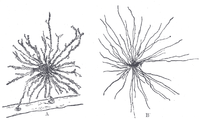
Photo from wikipedia
Isolation of multiple cell populations from limited starting material and with minimal influence on cell homeostasis and viability are common requirements in both basic and clinical research. Fluorescence‐activated cell sorting… Click to show full abstract
Isolation of multiple cell populations from limited starting material and with minimal influence on cell homeostasis and viability are common requirements in both basic and clinical research. Fluorescence‐activated cell sorting (FACS) is the most commonly applied sorting methodology with the majority of instruments being based on high pressure and electrostatic deflection. A more recent technology is based on a mechanical valve, operating at low pressure. In the present work we compared the two technologies by parallel sorting of small amounts of peripheral blood and umbilical cord blood on a BD FACSAria™ III and Miltenyi MACSQuant® Tyto® instrument. Concurrent manually performed magnetic‐based cell sorting served as reference. Sorting metrics, including purity and viability, were compared. Expression of the heat‐shock protein HSPA1A immediately post sorting and the proliferation potential of sorted T‐cells in vitro was assessed. In general, there was little to distinguish the two fluorescence‐activated technologies with regard to sorting metrics and HSPA1A expression. Variation, however, with respect to recovery and viability, was much smaller among Tyto sorted samples. The proliferation potential of Tyto‐sorted T‐cells was significantly higher compared to Aria‐sorted T‐cells, indicating that T‐cells of the Tyto instrument are less perturbed. In summary, cell types of blood origin including CD34+ cells could effectively be isolated from small input amounts with either fluorescence‐activated technology with little immediate effect on viability. The mechanical valve‐based sorting by the Tyto instrument; however, appeared to perturb the cells to a lesser extent as judged by their proliferation potential.
Journal Title: Cytometry Part A
Year Published: 2021
Link to full text (if available)
Share on Social Media: Sign Up to like & get
recommendations!